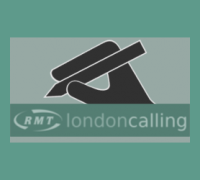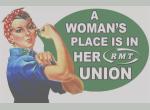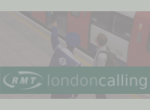Similar topics:
Women Working at Antwerp Port
Having begun working as a receptionist in 1975, Monique Verbeeck is the first female secretary of the Belgian port union, BTB. She is also the ITF and ETF women port workers’ representative. Monique introduced a deputation of women union activists from the Port of Antwerp, who addressed the meeting and took us on a visit to the port.
A DHL worker told us that port working is no longer entirely a “man’s world”, although it is still male-dominated.
The statistics: There are around 300 women working in the port, 3-4% of the total workforce. The numbers of women in particular jobs are: 38 general port work (entry grade, physical work); 108 markers (a less physical job); around 5 drivers; 3 assistant head markers (a very senior position); 45 fruit sorters (a “typically female” job); and one night foreman. The number of women is increasing – there were fourteen men and three women on the last general port work training course. There are around 100 women logistics workers in warehouses in the port areas – about 10% of the total.
Health and safety conditions are bad for both men and women. The Belgian port workers’ union, BTB, has achieved improvements for women, for example protections during pregnancy. Pregnant dock workers are taken off the shop floor for safety reasons, but retain only 90% of their wages.
A BTB seminar on toxic gases in containers saw ”frightening” reports from chemical companies: union campaigning has successfully established a new right for workers to refuse to unload a container if they have a concern, such as a bad smell. The union has held a Container Safety Day, asking workers to report dangerous or overloaded containers to the union. The women emphasised the importance of union representatives and stewards building trust and proactively asking people in workplaces about issues and incidents.
I proposed that the ETF Women’s Committee collate information on workers’ rights to refuse unsafe work in European countries, and examples of where women have exercised these rights. Committee members supported this proposal.
It is much harder for agency workers to exercise these rights – “the choice as they see it is to stand up for themselves or to have a job the next day”. Agency (or temporary, or “interim”) workers are in a similar situation now to that which women faced 20 years ago when they started working on the docks. The men were horrified –
“They’re taking our jobs! You can’t have women on the docks!”
Moreover, while port regulations are good, but workers in logistics companies outside the main ports are doing similar work in much worse conditions.
BTB has worked on the issue of breastfeeding. “The men laughed, but we want the right to breastfeed!”
In Belgium, workers have the right to ten days per year “social leave” (two days paid), but it is usually men, not women, who take this leave.
Bullying, harassment and violence against women port workers
Sexual harassment and violence remains an issue. The union has taken this up and achieved some progress. There is a nominated person that a victim can go to, so s/he doesn’t have to go straight to the boss. Workers have the right to paid leave to attend meetings as witnesses to bullying and harassment. There are measures against harassers, including dismissal. There are now fewer cases of harassment and violence.
However, where there is sexual harassment by a supervisor, it is often not easy to find a solution. In a recent case, the employee came off worse, although she did get compensation. Victims do not always automatically turn to trade unions for help in these situations. Liberalisation has made the situation worse – for example, “posted workers” don’t usually know who to turn to.
One rep had taken a call that morning from a young woman worker. Her boss had bullied her, using situations to put pressure on her at work, leading to her making mistakes. She has been sacked, and the union is campaigning for her reinstatement.
“There are laws, but are women aware that they are being harassed? We need to educate women to not tolerate harassment. Then, what about when women report and speak out against harassment? Half the people laugh at them. We have the right to demand that employers protect their workers.”
Visit to the Port of Antwerp
Antwerp’s port is the second largest in Europe – only Rotterdam is larger, and Hamburg is a little smaller. Antwerp handles around 8.6 million containers per year.
The port is staffed only by registered dockers, under rules similar to the UK's National Dock Labour Scheme, abolished by the Tories in the 1980s. The European Commission is attempting to scrap rules like this in Europe's ports, which trade unions justifiably fear would lead to worse safety standards and more deaths. Belgian port workers fear further attacks due to the recent election of “the most right-wing federal government we have ever seen”. Port trade unions across Europe are campaigning to defend dockers’ working conditions –a protest meeting and rally was due to be held in Norway the following week.
At any time, there are around 60,000 full containers stacked 3-4 high, and 120,000 empty containers stacked 8 high, in a terminal. A large ship, such as the SS Ariane, might carry 14,000 containers, with goods including steel products (coils, beams, sheet). Antwerp port operates during weekdays 06:00-22:00, with workers’ shifts being 06:00-13:30, 14:00-21:30 and 22:00-05:30.
We were due to visit a particular terminal, but it was closed, after a seafarer was killed while a ship was being loaded the previous day. I asked about the details of this tragedy: the seafarer had been watching dockers pile up bags for loading, and a pile had collapsed on top of him. He was taken to hospital, but died.
There is a health and safety authority for the whole port, including seven ex-dockers nominated by the unions.
I wrote a poem about this - Terminal 420.
You can download an ITF poster, The Changing Face of Dockers: Men and Women Working Together.
More information from ITF on women dockers, including a video, Women On The Waterfront:
- Janine's blog
- 4073 reads





